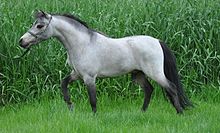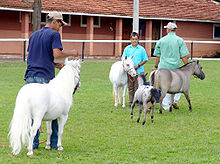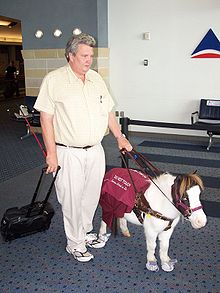- Miniature horse
-
Miniature Horse 
Miniature horse at show in EuropeDistinguishing features Small size, with horse phenotype 34–38 inches (86–97 cm) as measured at the last hairs of the mane Alternative names Mini horse Common nicknames Mini Horse (Equus ferus caballus) Miniature horses are found in many nations, particularly in Europe and the Americas. The designation of miniature horse is determined by the height of the animal, which, depending on the particular breed registry involved, is usually less than 34–38 inches (86–97 cm) as measured at the last hairs of the mane, which are found at the withers.[1][2] While miniature horses are the size of a very small pony, many retain horse characteristics and are considered "horses" by their respective registries. They have various colors and coat patterns.
Miniature horses are friendly and interact well with people. For this reason they are often kept as family pets, though they still retain natural horse behavior, including a natural fight or flight instinct, and must be treated like an equine, even if they primarily serve as a companion animal. They are also trained as service animals, akin to assistance dogs for people with disabilities.[3] While miniature horses can be trained to work indoors, they are still real horses and are healthier when allowed to live outdoors (with proper shelter and room to run) when not working with humans.[4]
They are generally quite hardy, often living longer on average than some full-sized horse breeds; the average life span of miniature horses is from 25 to 35 years.[5]
Contents
Organizations and registration requirements
There are two registries in the United States for Miniature Horses, the American Miniature Horse Association (AMHA) and the American Miniature Horse Registry (AMHR).
The AMHA was founded in 1978 and was dedicated to establishing the Miniature horse as a distinct breed of horse.[1][6] The AMHR is a division of the American Shetland pony Club and was established as a separate registry in 1972.[7] In the AMHA, Miniatures cannot exceed 34 inches at the withers (which the AMHA defines as located at the last hair of the mane). There are two divisions in AMHR - the "A" division for horses 34 inches (86 cm) and under, and the "B" division for horses 34 to 38 inches (86 to 97 cm).[2]
Worldwide, there are dozens of miniature horse registries. Some organizations emphasize breeding of miniatures with horse characteristics, others encourage minis to retain pony characteristics.[8]
The AMHA standard suggests that if a person were to see a photograph of a miniature horse, without any size reference, it would be identical in characteristics, conformation, and proportion to a full-sized horse.[1]
According to the AMHR, a "Miniature should be a small, sound, well-balanced horse and should give the impression of strength, agility and alertness. A Miniature should be eager and friendly but not skittish in disposition."[7]
Miniature Horse Club Great Britain (MHCGB) is able to register and issue passports to miniature horses with 50% or more American blood, at least one parent must be registered with the AMHA.
The UK American Miniature Horse Society (UKAMHS) is the only miniature horse organisation in Great Britain run specifically for American Miniature Horses. The UKAMHS is affiliated to the American Miniature Horse Association (AMHA).
Showing miniature horses
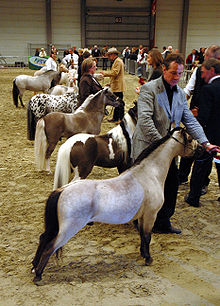 Miniature horses at a horse show.
Miniature horses at a horse show.
There are many horse show opportunities offered by registries and show sanctioning organizations worldwide. Some classes include: Halter (horse conformation), in-hand hunter and jumper, driving, liberty, costume, and obstacle or trail classes, and showmanship. There are Local, Regional, National, and "World" competitions.
History
Miniature horses were developed from multiple sources. Many different pony breeds were bred for small size, including the Shetland pony and the Dartmoor pony. There may also have been an infusion of bloodlines from certain breeds of full-sized horses.[9]
In the 17th century, miniature horses were bred as pets for Europe's Habsburg nobility. Records from the court of the French King Louis XIV, circa 1650, note the presence of tiny horses among the exotic creatures in the king's zoo. Paintings and articles featured the miniature horse by 1765. In England, Lady Estella Hope and her sisters carried on a breeding program from original English lines into the mid-nineteen hundreds. However, not all early miniatures were pampered pets of kings and queens. Some were used to work in the English Midlands, Wales and Northern European coal mines as pit ponies.[10]
In the United States, the miniature horse breed was refined during the 20th century. Miniature horses in the USA added additional lines from sources that included the Hackney Pony and the Pony of the Americas.
The Falabella miniature horse was originally developed in Argentina in 1868 by Patrick Newell. When Newell died, the herd and breeding methods were passed to Newell's son-in-law, Juan Falabella. Juan added additional bloodlines including the Welsh Pony, Shetland pony, and small Thoroughbreds. With considerable inbreeding he was able to gain consistently small size within the herd.
South Africa's Miniature Horses were developed in that nation and are known as the South African Miniature Horses, a recognized breed in its own right. Mr. Wynand de Wet of Lindley, South Africa, started in 1945 with two Shetland mares and a stallion. Through strict selection, their offspring became smaller and in 1991 Mr. de Wet bred a mare that was only 66 centimetres (26 in) tall.[11]
Controversies
Horse or pony?
There is an ongoing debate over whether a miniature horse should possess horse or pony characteristics. This is a common controversy within the miniature horse world and also is a hot debate between mini aficionados and other horse and pony breed owners. While technically any member of Equus caballus under 14 hands (142.24 cm) is termed a "pony," many breeds, including some miniature breeds, actually retain a horse phenotype and their breed registry therefore classifies them as horses.
Some miniature horse breed standards prefer pony characteristics such as short, stout legs and elongated torsos, while others prefer ordinary horse proportions.[12] Even the name is in dispute, terms such as "Midget Pony" and "Pygmy Horse" used in addition to "Miniature horse" and breed-specific names such as Falabella. The level of controversy is reflected by the presence of over 30 different registries for miniaturized horses or ponies just within the English-speaking world.[13]
Dwarfism
Dwarfism is a concern within the miniature horse world.[14] Dwarf horses, while often setting world records for size, are not considered to have desirable traits, generally have incorrect conformation, and may have significant health and soundness issues.[15][16][17] Therefore, many miniature horse registries try to avoid accepting minis affected by dwarfism for breeding stock registration.[18]
The oldest living horse on record was a miniature horse affected by dwarfism named Angel who lived with the Horse Protection Society of North Carolina and lived to be over 50.[5] The current record holder for the world's smallest horse is also a horse affected by dwarfism, Thumbelina, who is fully mature but stands 17 inches (43 cm) tall and weighs 60 pounds (27 kg). Though she has received considerable publicity, her owners have publicly stated that she will not be bred.[19] In 2010 a 6 pound miniature horse foal named Einstein challenged Thumbelina for the title of the World's Smallest Horse in part based upon the idea that there should be a separate world record category for the smallest non-dwarf horse. [20]
Assistance animals
There is controversy over whether miniature horses are suitable as assistance animals for the blind. Those who favor their use point out that horses live much longer than dogs and can be trained to perform similar tasks. Another plus is that some individuals, particularly from Muslim cultures, consider dogs unclean, but accept horses.[21] Opponents of their use raise concerns that miniature horses are prey animals, with a fight or flight instinct that may limit their usefulness, and for legal reasons.[citation needed] In the US, where they are legally classified as livestock and require outdoor stabling for good health, their use is limited to owners with access to a large yard in communities having tolerant land use regulations. In terms of practical considerations, they note that it is difficult for even a miniature horse to do things such as lie down in the seat of a taxicab or to stay in a hotel room for extended periods of time.
See also
References
- ^ a b c American Miniature Horse Association
- ^ a b American Miniature Horse Registry
- ^ Guide Horse Foundation
- ^ "Horses in your house," web site, accessed January 17, 2007
- ^ a b "Miniature Horse Facts"
- ^ "The History of Miniature Horses and Ponies." Web site, accessed January 17, 2007
- ^ a b "Unique -- Interesting -- A Class All of lts Own," The Journal of The American Shetland Pony Club Accessed January 17, 2007
- ^ "The Top 20 Miniature Horse Registries," web site, accessed January 17, 2007
- ^ "Mini Horse Breeds" Accessed January 17, 2007
- ^ "American Miniature Horse" from International Museum of the Horse, Kentucky Horse Park. Web page accessed September 2, 2007
- ^ "South African Miniature Horse History." Web site accessed March 18, 2007
- ^ Mini Horse History
- ^ List of Miniature Horse Registries
- ^ "Dwarfism in Miniature Horses"
- ^ "Dwarf Miniature Horses." Web site accessed March 18, 2007
- ^ "Dwarf information"
- ^ "Dwarf miniature horse health care"
- ^ Ashby, Barbara. "Dwarfism in Miniature Horses." Miniature Horse World, , p. 37-39 June/July issue, publication year unclear, web page accessed September 2, 2007.
- ^ "Meet Thumbelina, the World's Smallest Horse," Daily Mail, October 8, 2006
- ^ [1]
- ^ http://www.msnbc.msn.com/id/30155540/ns/health-health_care/
External links
- American Miniature Horse Association
- American Miniature Horse Registry
- Miniature Horse Information Center
- The Miniature Horse Informational Guide
- International Museum of the Horse
- American Miniature Horse in France
- Association Française du Cheval Miniature
- Miniature Horse Club of Great Britain
Equine Equine science and
management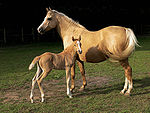
Equestrianism
and sportGlossary of equestrian terms · List of Equestrian Sports · Horse tack · Bit · Bridle · Saddle · Harness · English riding · Western riding · Driving · Horse training · Horse racing · Equestrian at the Summer Olympics (medalists, venues) · Horse show · EquitationEvolution and history Domestication · In warfare · In the Middle Ages · Horses in East Asian warfare · History of the horse in South Asia · Horses in the Napoleonic Wars · Horses in World War I · Horses in World War II · History of the horse in BritainHorse breeds, types
and other EquidaeList of horse breeds · Wild horse · Feral horse · Stock horse · Gaited horse · Draft horse · Warmblood · Sport horse · List of horse breeds in DAD-ISOther EquusHybridsCategories:- Horse breeds
Wikimedia Foundation. 2010.

